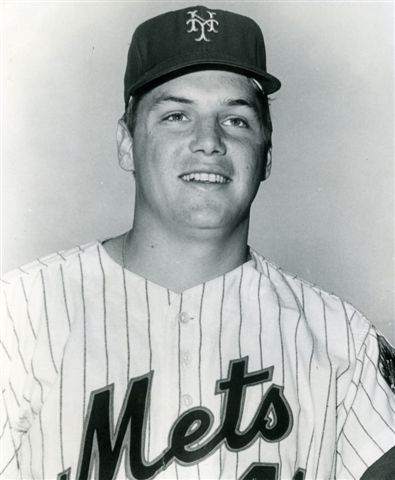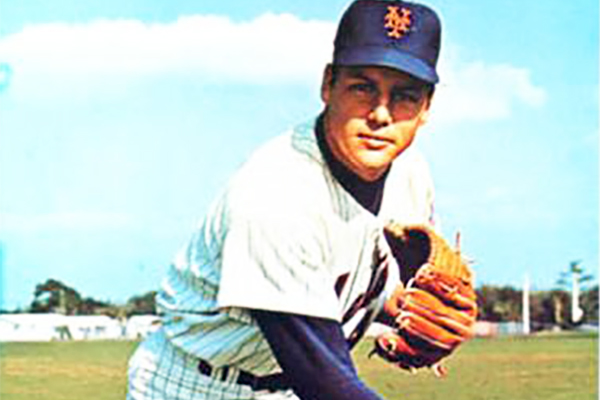In Memoriam: Tom Seaver
Few players were ever more connected to a baseball franchise than “Tom Terrific” with the New York Mets.
Certainly, no member of the team was as intricately associated with their meteoric rise from cellar dwellers to world champions in 1969, as Maxwell Kates wrote in his SABR biography of Hall of Fame pitcher Tom Seaver, who died at the age of 75 on Monday, August 31, 2020, due to complications from Lewy body dementia and COVID-19.
With his signature drop-and-drive delivery that produced 311 wins, 3,640 strikeouts, and three Cy Young Awards over a 20-year career with the Mets, Cincinnati Reds, Chicago White Sox, and Boston Red Sox, Seaver delivered so many memorable moments that it’s hard to choose his most meaningful performance: his near-perfect game against the first-place Cubs in 1969, his record-setting 19 strikeouts against the Padres in 1970, his no-hitter with the Reds in 1978, his long-awaited return to the Mets in 1983, his complete game at age 40 for his 300th career win at Yankee Stadium in 1985. They’re all as lovingly remembered as the stain of dirt on his right knee as he delivered his blazing fastball.
Any fans alive for the Miracle Mets’ run in 1969 will never forget Seaver’s 10-inning masterpiece to win Game Four of the World Series against the heavily favored Baltimore Orioles. Seaver and the Mets took part in a ticker-tape parade described by the Wall Street Journal as “a more colossal celebration than V-E Day, Charles Lindbergh’s flight, and the return of the Apollo astronauts, all rolled into one.”
 It’s impossible to overstate how quickly and dramatically Seaver turned the franchise’s fortunes around when he arrived as a rookie from the University of Southern California in 1967. (The Mets were the lucky winners of a three-team lottery for his services due to a contractual violation by the Atlanta Braves, who signed him while he was still in college.) The Mets had been the laughingstock of baseball since their inaugural season in 1962, when they lost a record 120 games. They had never finished higher than ninth place in the National League before suddenly winning it all in 1969.
It’s impossible to overstate how quickly and dramatically Seaver turned the franchise’s fortunes around when he arrived as a rookie from the University of Southern California in 1967. (The Mets were the lucky winners of a three-team lottery for his services due to a contractual violation by the Atlanta Braves, who signed him while he was still in college.) The Mets had been the laughingstock of baseball since their inaugural season in 1962, when they lost a record 120 games. They had never finished higher than ninth place in the National League before suddenly winning it all in 1969.
Seaver’s emergence as the National League Rookie of the Year in ’67 was followed by his first of three Cy Young Awards in 1969, when he went 25-7 with a 2.21 ERA and 208 strikeouts. He won his second Cy Young in 1973, when the Mets captured their second NL pennant and fell to the Oakland A’s in the World Series. He racked up nine consecutive 200-strikeout seasons along with a third Cy Young Award in 1975.
The one accomplishment that eluded him with the Mets was a no-hitter, which he finally accomplished following a controversial midseason trade to Cincinnati in 1977, dubbed the “Midnight Massacre” by distraught New Yorkers. On June 16, 1978, he took a no-hitter into the ninth inning for the fourth time — and this time Seaver came out on top against the St. Louis Cardinals at Riverfront Stadium.
Seaver made a much-heralded return to the Mets in 1983 before finishing his career with the White Sox — with whom he won his 300th game on August 4, 1985 — and the Red Sox in 1986. His election to the National Baseball Hall of Fame in 1992 set a record for the highest voting percentage ever recorded: 98.8 percent. The mark lasted for a generation, until it was surpassed by Ken Griffey Jr. in 2016.
Generations of Mets fans still consider Tom Terrific to be the savior of their favorite team and the face of the franchise. His number 41 will never be worn again by a Mets player, a statue of his likeness will soon stand outside Citi Field in Flushing Meadows, and the street outside the ballpark is named Tom Seaver Way. In life and in death, his name will forever be synonymous with the New York Mets.
Related links:
- Read Tom Seaver’s SABR biography, by Maxwell Kates
- Tyler Kepner: ‘He Was the Perfect Pro’: Tom Seaver’s Senses Made Him a Baseball Great (New York Times)
- Keith Olbermann: Tom Seaver dies at 75 (ESPN.com)
- Jay Jaffe: Remembering the Terrific Tom Seaver (FanGraphs)
- Steven Goldman: Terrific Tom Seaver and His Times (Baseball Prospectus)
- Michael Baumann: Tom Seaver Was the Best Pitcher of His Generation—and Maybe Every Other Generation, Too (The Ringer)
- Rustin Dodd: The Franchise: Tom Seaver, a baseball artist and a Mets icon, dies at 75 (The Athletic)
- Mark Armour: Tom Seaver, 1944-2020 (SABR Baseball Cards Blog)
Originally published: September 2, 2020. Last Updated: September 4, 2020.



